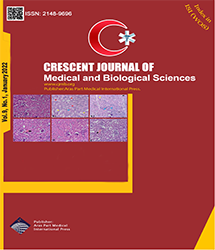| Original Article | |
| Reproductive and Menstrual Risk Factors for Endometriosis Disease: A Case-Control Study | |
| Sanaz Mollazadeh1, Mahin Kamalifard2, Behnaz Sadeghzadeh Oskouei2, Nayyereh Aminisani3, Mehri Jafari Shobeiri4, Mojgan Mirghafourvand5 | |
| 1Students’ Research Committee, Nursing and Midwifery Faculty, Tabriz University of Medical Sciences, Tabriz, Iran 2Nursing and Midwifery Faculty, Tabriz University of Medical Sciences, Tabriz, Iran 3Faculty of Health, Tabriz University of Medical Sciences, Tabriz, Iran 4Medicine Faculty, Tabriz University of Medical Sciences, Tabriz, Iran 5Social Determinants of Health Research Center, Tabriz University of Medical Sciences, Tabriz, Iran |
|
|
CJMB 2022; 9: 043-050 DOI: 10.34172/cjmb.2022.08 Viewed : 4037 times Downloaded : 2847 times. Keywords : Case-control study, Reproductive characteristics, Menstrual characteristics, Endometriosis |
|
| Full Text(PDF) | Related Articles | |
| Abstract | |
Objectives: The endometriosis prevalence in the general population is about 7%-10%. In 30% of women, endometriosis is one of the causes of primary and secondary infertility. There are various risk factors for this disease. The present study aimed to determine the reproductive and menstrual risk factors of endometriosis. Materials and Methods: In this case-control study, 185 women of reproductive age with confirmed endometriosis were compared with 370 women of reproductive age who referred to the same center for other problems in terms of reproductive and menstruation risk factors for endometriosis. The two groups were matched for age. Data were collected using a researcher-made questionnaire based on previous studies. Finally, bivariate analysis was done by the chi-square test, and multivariate analysis was performed by the conditional logistic regression for controlling confounder variables. Results: Based on multivariate logistic regression, early menarche age (P = 0.004), no history of pregnancy (P < 0.001), no child (P = 0.002), no lactation history (P < 0.001), high age of the first lactation (P = 0.029), short duration of breastfeeding (P = 0.015), no regular menstruation (P < 0.001), short intervals between menstrual bleedings (P = 0.016), prolonged menstruation (P < 0.001), dysmenorrhea (P < 0.001), dyspareunia (P < 0.001), and recurrent vaginitis (P < 0.001) had a significant relationship with endometriosis. Conclusions: In general, there was a relationship between some reproductive and menstrual characteristics and endometriosis. Therefore, it seems that these characteristics can predict the occurrence of endometriosis disease. |
Cite By, Google Scholar
Google Scholar
PubMed
Online Submission System
 CJMB ENDNOTE ® Style
CJMB ENDNOTE ® Style
 Tutorials
Tutorials
 Publication Charge
Medical and Biological Research Center
About Journal
Publication Charge
Medical and Biological Research Center
About Journal
Aras Part Medical International Press Editor-in-Chief
Arash Khaki
Deputy Editor
Zafer Akan


















